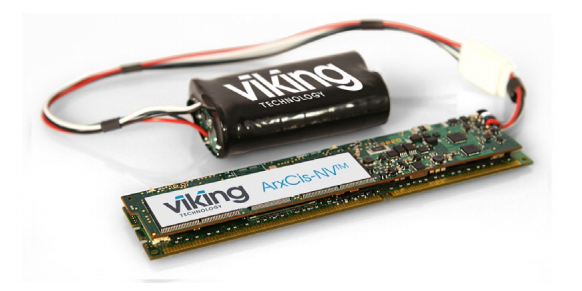Viking Announces Development of NVDIMM DDR3 Memory
Viking is also working on an NVDIMM technology.
Almost two months ago, we showed you that Micron was working on NVDIMM memory. Now, Viking has announced that it is working on its ArxCis-NV RAM memory.
Normally, RAM memory loses all the data on it the moment that the power is cut. Micron and Viking's workarounds to this are almost identical. The identical part is that both the solutions are based on a certain amount of DRAM memory, which is coupled with exactly twice as much NAND memory. Upon losing power, all the data that was on the DRAM memory would be written to the NAND memory.
The difference between Micron's approach and Viking's is in the power delivery system. While the Micron system works with modern high-capacity capacitors, Viking's approach works with coupled batteries.
Viking's ArxCis-NV DIMMs would work in essentially any DDR3 memory slot. Beyond the security that the added NAND offers, the unit should also extend the lifetime of servers' SSDs. Currently, many systems make backups of the contents of the memory to an SSD with regular intervals in case of power loss, Viking's ArxCis-NV wouldn't need to make backups as frequently since it would automatically save all the data to the onboard NAND upon power loss. This would reduce the amount of writes to SSDs, which should notably increase their lifespan.
Obviously, the product is not targeted at consumers, but rather companies that have servers carrying large amounts of data and needing the most reliable setups. The ArxCis-NV would also be too expensive for consumer use.
According to Viking, its ArxCis-NV DIMM will first hit the market in an 8 GB version with 16 GB of NAND memory. According to Viking, it will cost about $200. A 16 GB version is scheduled for a later release.
Contact Us for News Tips, Corrections and Feedback
Get Tom's Hardware's best news and in-depth reviews, straight to your inbox.
Niels Broekhuijsen is a Contributing Writer for Tom's Hardware US. He reviews cases, water cooling and pc builds.
-
Shin-san Hm... I wonder if a traditional OS would have to be rewritten to take advantage of thatReply -
slomo4sho Let me open up my case to power down my ram so I can dump the system memory... Definitely not aimed at the consumer markets :PReply -
jkflipflop98 Something like this for the consumer means insta-booting. Your computer will work like your tv or microwave - you push the button and it's ready to go.Reply -
A Bad Day jkflipflop98Something like this for the consumer means insta-booting. Your computer will work like your tv or microwave - you push the button and it's ready to go.Reply
But it also makes it even easier to steal data should someone gets access to your computer.
One of the easiest ways of bypassing security systems is through cold boot attack. Turn on computer, freeze the RAM sticks with compressed air to reduce memory bit loss, plug them into another device where you can recover lost bits (since bits are lost in a predictable pattern upon power loss), and read the data contents.
By ensuring that the RAM is never erased even when unplugged, you just made a hacker's dream come true. -
A Bad Day EDIT: And such attacker can also break a hard-drive encrypted with AES-256, since the encryption key is stored in the RAM.Reply
https://www.youtube.com/watch?v=JDaicPIgn9U -
joytech22 "According to Viking, it will cost about $200."Reply
B**tch please. 3 years ago I spent that on 8GB of RAM.
Too expensive for consumers my ***. lol -
A Bad Day joytech22"According to Viking, it will cost about $200."B**tch please. 3 years ago I spent that on 8GB of RAM.Too expensive for consumers my ***. lolReply
"So uh, our 24/7 critical server went down with some important data on them that haven't been written to the SSDs yet, and we have like 10,000 employees unable to do anything because of it..."
OR:
"So uh, we need to replace the SSDs. There's been a large spike in failures from all of the writing. If it keeps up, our RAID setup may fail completely..." -
ojas A Bad DayBut it also makes it even easier to steal data should someone gets access to your computer.One of the easiest ways of bypassing security systems is through cold boot attack. Turn on computer, freeze the RAM sticks with compressed air to reduce memory bit loss, plug them into another device where you can recover lost bits (since bits are lost in a predictable pattern upon power loss), and read the data contents.By ensuring that the RAM is never erased even when unplugged, you just made a hacker's dream come true.Or, just steal the hard drive. :PReply

